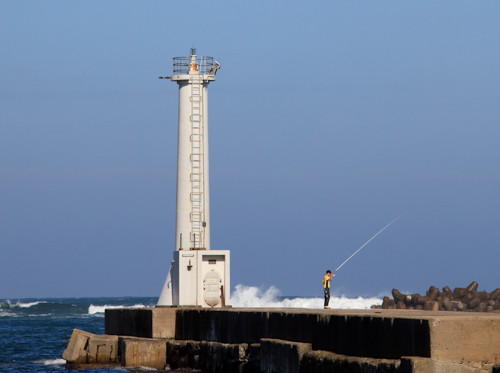The nation of Japan, known in Japanese as Nihon or Nippon (日本), occupies an archipelago off the east coast of Asia. The four main islands are Hokkaidō in the north, Honshū (the largest) in the center, Shikoku in the south, and Kyūshū in the southwest. The country includes thousands of other islands of all sizes; among them the Ryūkyū (Nansei) Islands are a long chain extending to the southwest and including the large island of Okinawa, and the Nanpō Islands are another long chain extending south into the Pacific Ocean. Much of Japan is mountainous but the coastal regions are densely populated and urbanized; the country's population is about 126 million.
Japan is divided into 47 prefectures. This page describes lighthouses of Fukushima Prefecture on the east coast of Honshū. Facing the Pacific Ocean, the coast of Fukushima is relatively low by Japanese standards. Onahama, the harbor district of Iwaki City, is the major port.
This coast was devastated by the great Tōhoku earthquake and tsunami of 11 March 2011. The major lighthouses are high enough above the sea to escape the tsunami; all were damaged by the earthquake to some extent but they have been returned to service. Many harbor lights, however, were overturned or destroyed by the tsunami. In addition to the direct damage from the tsunami Fukushima also suffered the disastrous failure of its nuclear power plant; as a result a part of the prefecture has been closed to the public since the disaster. Along the coast the exclusion zone includes most of the coastline of Futaba, all of the coastline of Okuma, and the northern coastline of Tomioka.
In Japanese the word for a lighthouse is tōdai or toudai (灯台). The words saki and misaki are for capes and headlands, hana ("nose") is a promontory, hantō is a peninsula, shima (also spelled sima or jima) is an island, bae is a reef, iwa or shi is a rocky reef, amase or se is a shoal, wan is a bay, nada is a sound or basin, kaikyō is a strait, kawa is a river, and kō or minato is a harbor.
Lighthouses in Japan are operated and maintained by the Japanese Coast Guard's Maritime Safety Agency. On Honshū there is usually one Coast Guard Section Office in each prefecture. That is the case in this region, with one section office at Fukushima City.
ARLHS numbers are from the ARLHS World List of Lights. JCG numbers are the Japanese Coast Guard's light list numbers. Admiralty numbers are from volume M of the Admiralty List of Lights & Fog Signals. U.S. NGA List numbers are from Publication 112.
- General Sources
Lighthouses in Japan - Fukushima - A site providing photos and data for most major Japanese lighthouses.
- Lighthouse-Japan.com - Fukushima
- Another comprehensive site with photos and notes from visits to many lighthouses.
- Form of a Lighthouse - Fukushima Prefecture
- This site has photos from recent visits with notes about access; it is cited below as FOAL (Form of a Lighthouse).
- Misty's Japanese Lighthouse Tour - Fukushima
- Photos and notes for lighthouses in all parts of the country.
- Lighthouse Visits
- This site has photos for many lighthouses in this area.
- Lighthouses in Fukushima Prefecture
- Photos by various photographers available from Wikimedia.
- About the Fukushima Maritime Safety Agency
- This page on the Coast Guard Office's web site has small photos and historical information for three of the major lighthouses.
- Online List of Lights - Japan - Honshu East Coast
- Photos by various photographers posted by Alexander Trabas

Uno O Saki Light, Sōma, April 2019
Google Maps street view






